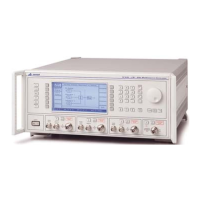MEMORY
46882/439 3-47
(3) Press [EXIT] to return to the Memory Store Menu.
Memory protection menu
(4) To change the write protection, the instrument must be unlocked to Level 1 (see ‘Protection
locking and unlocking’ on page 3-38). Subsequently pressing [
Memory Protect] causes the
Memory Write Protection Menu similar to that shown in Fig. 3-45 below to be displayed.
B3483
Fig. 3-45 Memory write protection menu
(5) Select the type of memory stores to be changed by selecting between [Full Stores], [Carrier
Stores] and [RAM Stores]. An unprotected store is indicated by a dash (−), a protected store
is indicated by the letter p.
(6) To change the protection for a memory block enter the [Block Start] and [Block Stop]
numbers. For a single store make both numbers the same.
(7) Select [Protect] or [Unprot.] as required. This action is acknowledged by the message
** Protected ** or ** Unprotected ** appearing respectively.
(8) Press [EXIT] to return to the Memory Store Menu.
Note that at power-on the volatile RAM stores are unprotected to allow immediate use.
Memory recall
There are three types of recall: carrier, full and RAM. Both carrier and full stores are non-volatile.
The contents of the RAM store are lost when the instrument is switched off.
Carrier recall
The non-volatile carrier frequency store has 100 locations numbered 0 to 99 for carrier frequency
only. These can be recalled and used in conjunction with full recall to apply a set of test
conditions to a range of frequencies.
Full recall
The non-volatile store has 100 locations numbered 0 to 99 for the storage of instrument settings.
These stores may be recalled and used to reset the instrument’s parameters to those which affect
the RF output: carrier frequency, RF level, modulations in use, on/off and source information and
the two modulation oscillator frequencies in use.
RAM recall
The volatile RAM store has 100 locations numbered 0 to 99 for the full storage of instrument
settings. The parameters that are recalled are the same as those for full recall.

